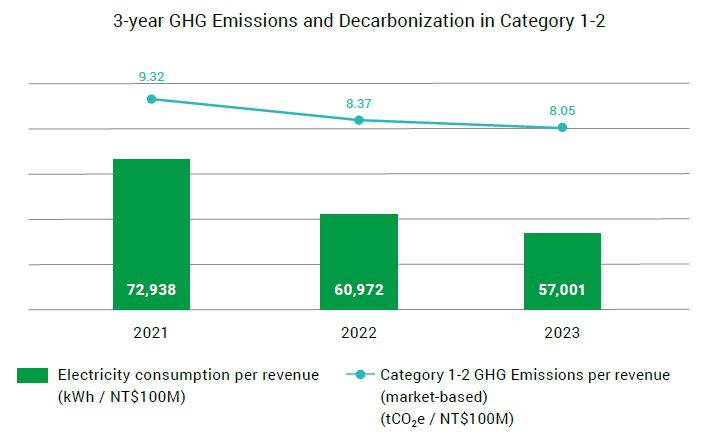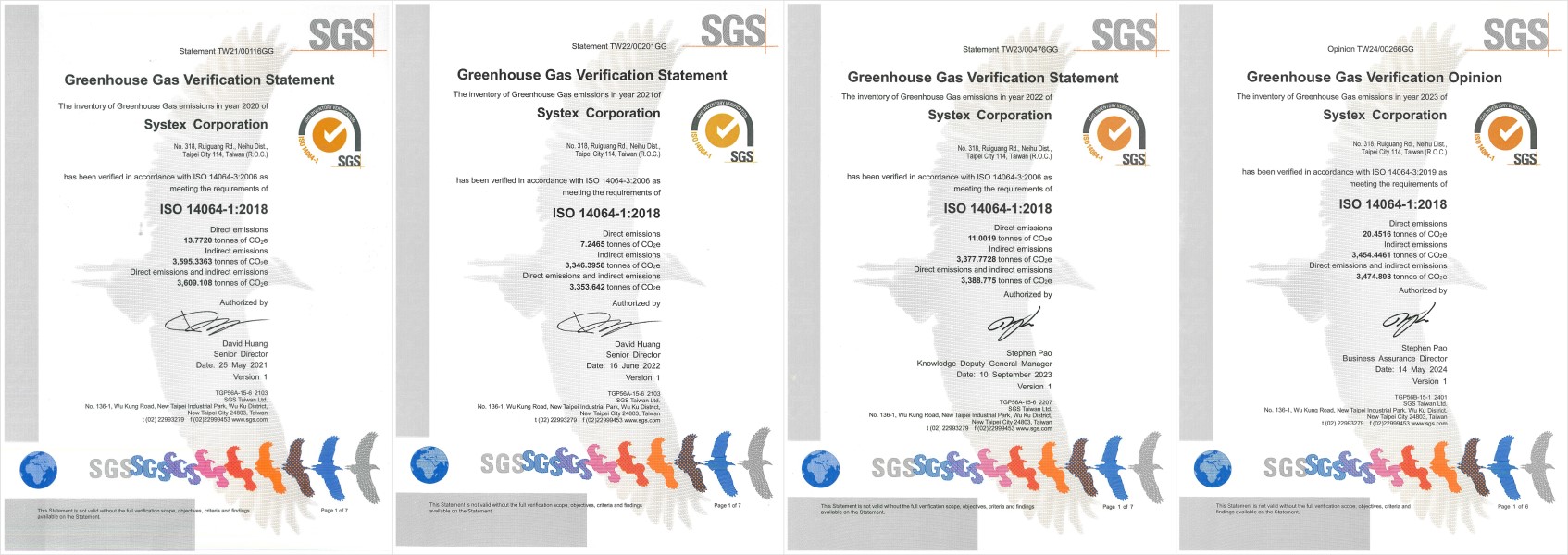Greenhouse Gas Management
In order to measure GHG emissions more accurately, SYSTEX has introduced GHG Inventory since 2021 and conducts GHG Inventory every year according to the guidelines of “ISO 14064-1: 2018”, to formulate improvement plans accordingly. For the inventory, SYSTEX has set up a “GHG Inventory Committee” to prepare audit reports and to conduct data audit according to the “Internal Audit Management Procedures”, and then entrusted an independent third-party to conduct external audit, ensuring its correctness and completeness. The boundary of GHG inventory is the headquarters building.
In 2023, the total market-based GHG emissions of the SYSTEX headquarters building was 3,474.9 tCO2e, of which the electricity consumption accounted for the highest proportion of emissions, reaching 80.89%.
SYSTEX conducts Headquarters GHG inventory of category 1-6, using the parameters released by the IPCC AR6, Ministry of Environment, or relevant authorities. The inventory covers:
- Category 1: Direct GHG emissions
SYSTEX counts emission sources in the headquarters building, including the sources of stationary combustion, mobile combustion and fugitive.
- Category 2–6: Indirect GHG emissions
All emission sources of category 2-6 have been discussed by the “GHG Inventory Committee” according to the guidelines of “ISO 14064-1: 2018”, and should be defined as significant emissions with a score over 30.
Category 2 emissions are generated by imported energy.
Category 3-4 emissions are calculated from business travels, indirect carbon footprint of electricity and disposal of general waste.
- Emission Factor
The emission factors are based on the latest data published by the IPCC AR6, Ministry of Environment, or relevant authorities.
2023 Greenhouse Gas Emissions
GHG Emissions (Category 1-6) [Scope: SYSTEX headquarters building]
| Category | Emission Source | Emissions (tCO2e) | ||
| Subtotal | Total | |||
| Category 1: direct GHG emissions | Stationary combustion | 7.8538 | 20.4516 | |
| Mobile combustion | 5.9797 | |||
| Fugitive (anthropogenic systems) | 6.6181 | |||
| Category 2: indirect GHG emissions from imported Energy | Imported electricity | Location-based (Market-based) |
2,8104.9551 (2,8104.9551) |
|
| Category 3: indirect GHG emissions from transportation | Employee commuting and business travels | Business travel by THSR | 7.1079 | 78.0482 |
| Business travel by airplanes | 39.1614 | |||
| Business travel by taxi | 31.7789 | |||
| Category 4: indirect GHG emissions from products used by organization | Purchased goods | Indirect carbon footprint of electricity | 554.8089 | 565.4428 |
| Disposal of waste | Disposal of general waste | 10.6339 | ||
| Category 5: indirect GHG emissions associated with the use of products from the organization | No significant emissions | |||
| Category 6: indirect GHG emissions from other sources | No significant emissions | |||
| Category 1-6 GHG emissions | Location-based (Market-based) |
3,474.8977 (3,474.8977) |
||
Direct GHG Emissions (Category 1) [Scope: SYSTEX headquarters building]
| Item | CO2 | CH4 | N2O | HFCs | PFCs | SF6 | NF3 | Total |
| GHG emissions (tCO2e) | 13.5481 | 0.0670 | 0.2184 | 6.6181 | 0 | 0 | 0 | 20.4516 |
| Proportion | 66.24% | 0.33% | 1.07% | 32.36% | 0.00% | 0.00% | 0.00% | 100.00% |
Greenhouse Gas Management Performance
Through the ISO 14064-1 GHG inventory, SYSTEX found that purchased electricity produced the highest proportion of emissions. Therefore, in addition to implementing various environmental and energy management measures, SYSTEX purchases and rents equipment with environmentally-friendly labels, replaces power-consuming equipment every year, regularly checks pipelines, and sets the office temperature to no less than 26°C, thereby reducing electricity consumption and environmental load. Furthermore, SYSTEX also supports RE development, signing the RE Wheeling Contract in 2022 to use 120,000 kWh of renewable energy in 2023. Furthermore, SYSTEX has planned and launched an “Internal carbon pricing measure” in 2024, charging internal carbon fee to increase RE consumption and reduce GHG emissions.
3-year GHG Emissions of Category 1-2 [Scope: SYSTEX headquarters building]
In 2023, due to the increase in the business scale, SYSTEX increased electricity consumption, However, if we checked the electricity consumption per revenue, it has been on a downward trend for the past 3 years, showing that SYSTEX is gradually improving its electricity consumption efficiently. In addition, SYSTEX launches an “Internal carbon price measure” in 2024 to increase the RE consumption.

| Item | 2020 (base year) |
2021 | 2022 | 2023 |
| Category 1 GHG Emissions (tCO2e) | 13.7720 | 7.2465 | 11.0019 | 20.4516 |
| Category 2 | ||||
|
5,692,079 | 5,536,879 | 5,665,093 | 5,810,192 |
|
100,000 | 72,000 | 83,493 | 120,000 |
|
2,897.2682 | 2,779.5135 | 2,804.2210 | 2,810.9551 |
|
2,846.3684 | 2,743.3695 | 2,762.8922 | 2,810.9551 |
| Category 1-2 GHG Emissions (tCO2e) | ||||
|
2,911.040 | 2,786.760 | 2,815.223 | 2,831.407 |
|
2,860.140 | 2,750.616 | 2,773.894 | 2,831.407 |
| SYSTEX consolidated revenue (NT$100M) | 237.35 | 295.27 | 331.29 | 351.84 |
| Electricity consumption per revenue (kWh / NT$100M) | 86,447 | 72,938 | 60,972 | 57,001 |
| GHG Emissions per revenue (tCO2e/NT$100M) | ||||
|
12.265 | 9.438 | 8.498 | 8.407 |
|
12.050 | 9.316 | 8.373 | 8.407 |
Greenhouse gas emission data in the past 4 years have been audited by SGS (2021-2024)

- ISO 14064-1 GHG Verification Statement (2021/05/25)
- ISO 14064-1 GHG Verification Statement (2022/06/16)
- ISO 14064-1 GHG Verification Statement (2023/09/10)
- ISO 14064-1 GHG Verification Statement (2024/05/14)

